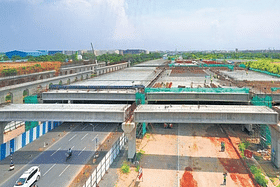Once completed, the IGI Airport will be the only airport in the country to have an elevated taxiway with roads passing beneath it.
Delhi International Airport Limited (DIAL), which manages and operates the Indira Gandhi International (IGI) Airport, is making preparations to introduce a unique infrastructure project.
GMR Airports Infrastructure is leading the construction of elevated dual taxiways that will connect the northern and southern airfields on the eastern side of the airport. This will be the first of its kind in India.
The main objective of this innovative infrastructure is to reduce the distances that aircraft need to taxi, resulting in lower emissions and fuel consumption. This will not only conserve natural resources like aviation turbine fuel (ATF) but also enhance the overall operational efficiency of the airport.
The introduction of elevated dual taxiways is expected to have a significant impact on aircraft taxiing time, as well as provide environmental benefits through reduced emissions and fuel conservation.
Furthermore, it will contribute to the smooth functioning and improved operational efficiency of the airport. It is estimated that this taxiway project will optimise taxiing routes and aircraft operations, leading to a reduction of approximately 55,000 tonnes of CO2 emissions every year.
Once completed, the IGI Airport will be the only airport in the country to have an elevated taxiway with roads passing beneath it.
In addition to the environmental benefits, the elevated dual taxiways will also enhance the passengers’ experience. With shorter taxiing distances, passengers will spend less time inside the plane after landing or during take-off.
For example, the distance an aircraft needs to cover from the third runway to T1 will be reduced from the current nine kilometres to just two kilometres. This improvement will contribute to a more efficient and enjoyable travel experience for passengers.
The dual-lane elevated Code F taxiways at the airport can accommodate large aircraft and wide-body jets like the A380, B777, and B747-8. The Eastern Cross Taxiway consists of two 44m wide lanes with a gap of 47m between them, allowing for the safe and simultaneous passage of two large aircraft.
As part of its mission to create a sustainable future, DIAL has set an ambitious goal of becoming a “Net Zero Carbon Emission Airport” by 2030, according to an Economic Times report
During the event, I Prabhakara Rao, Deputy MD of GMR Group, expressed his satisfaction with the achievement, stating that it is a testament to DIAL’s commitment to environmentally sustainable architecture and their goal of becoming a “Net Zero Carbon Emission Airport” by 2030. The Eastern Cross Taxiway not only improves the passenger experience but also prepares Delhi airport for the future.
In addition to the Eastern Cross Taxiway, the IGI Airport’s Phase 3 expansion includes plans for a new fourth runway, a larger and integrated Terminal 1, an expanded T1 apron for aircraft parking, new taxiways, landside developments, and various technological enhancements.


